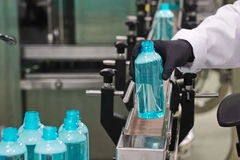US PET bottle recycling rates rise as infrastructure and consumer participation improve

PET bottle recycling rates across the US reached record levels in 2023, according to the National Association for PET Container Resources’ (NAPCOR) latest 2023 PET Recycling Report.
Laura Stewart, NAPCOR’s executive director, tells Packaging Insights that NAPCOR saw a modest increase (2.7%) in collection over 2022, driven by gains in material supplied through curbside collection to PET recyclers.
But the biggest driver of the higher recycling rate was the decrease in the weight of bottles available for recycling by 9.8%.
“Domestic PET resin sales to bottle applications and total imports of PET resin were lower compared to 2022. Both virgin and recycled resin sales to non-food / non-beverage bottle applications (for example, personal care and household products) were down by significant percentages,” says Stewart.
The US PET bottle collection rate was 33% in 2023, up four percentage points from 29% in 2022 — the highest recycling rate in the US since 1996.
The average amount of recycled PET in US bottles and jars was 16.2% in 2023, up three percentage points from 13.2% in 2022. “This is the highest level ever and demonstrates increased demand for recycled PET nationwide,” says NAPCOR.
 Well-designed EPR programs can help bridge the gap between high consumer access and low recycling participation.EPR and DRS effects
Well-designed EPR programs can help bridge the gap between high consumer access and low recycling participation.EPR and DRS effects
Recycling infrastructure and consumer support are crucial to the successful recycling of PET.
As PET bottles cannot be recycled if they are not collected, Stewart stresses that a national Extended Producer Responsibility (EPR) law is imperative to improve and scale collecting, sorting and recycling systems.
“EPR programs around the world have proven to be financially sustainable and successful when they are co-designed and led by industry with proper oversight from governments,” she says.
“In the US, dozens of packaging EPR bills have been introduced over the past four years, and Maine, Oregon, California, Colorado and Minnesota have passed EPR legislation for packaging of all material types, covering 20% of the US population.”
“Additionally, Illinois and Maryland are now assessing their needs as a potential EPR precursor, and it’s expected that more states will continue to pass EPR for packaging over the next few years.”
Regarding consumer participation, Stewart shares that although 88% of US residents have access to PET bottle recycling, the fraction of those participating in the recycling system is significantly lower.
“Well-designed EPR programs — which include recycling refund programs, known as deposit return systems — can help bridge that gap by placing a value on post-consumer PET bottles, thereby incentivizing their recycling.”
“A recent MIT study indicates that a nationwide DRS could increase recycling rates to 82% for all recyclable materials, including PET bottles. Strong policies like EPR and DRS recycling refund programs help accelerate and perpetuate a circular economy, reduce the need to create new PET plastic, keep our country clean and enable governments and brands to achieve aggressive environmental targets,” she adds.
Depolymerization to boost recycling  NAPCOR sees depolymerization, a form of chemical recycling for PET, coming into play.
NAPCOR sees depolymerization, a form of chemical recycling for PET, coming into play.
Stewart says that in Oregon, smart policies like bottle redemption programs have helped achieve a PET plastic bottle recycling rate of over 70%. “Though only ten US states have bottle redemption programs, we estimate that they account for more than 40% of US PET bottle collection.”
“This demonstrates how public education and well-designed policies can dramatically improve recycling outcomes. NAPCOR’s goal is to support policies that would replicate this success nationwide by inspiring consumers to see the value of PET plastic and make recycling it part of their routine.”
Regarding the future landscape of US PET recycling, Stewart says that in addition to mechanical recycling, NAPCOR sees depolymerization, a form of chemical recycling for PET, coming into play with the start-up of Eastman’s plant earlier this year.
“This means there are emerging markets for non-clear PET and other feedstocks beyond packaging such as polyester textiles.”
“There has also been investment in circular thermoform recycling (also called ‘tray-to-tray’), and this end market pull should drive more recovery of non-bottle packaging,” says Stewart.











